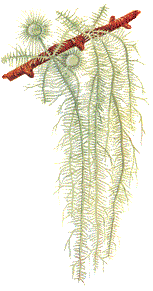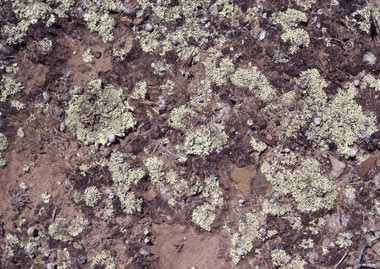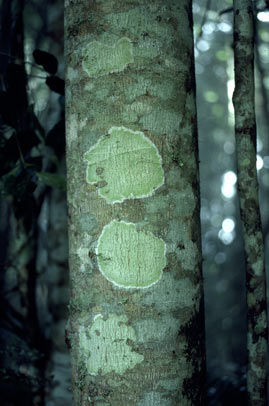
Ecology
You can find lichens from the cold arctic and antarctic to the hot deserts of the world and from sea level to alpine peaks. Some species may be found in a wide variety of habitats while others have a very restricted range. You can find lichens growing on a wide variety of natural and man-made substrates. It should therefore not surprise you to learn that, as a group, lichens show a wide range of behaviours and interactions with other organisms. Lichen ecology is clearly a large subject so that, necessarily, there will be a fairly limited coverage on this website![]() .
.
Habitats
There are various factors which determine where you will find a particular species of lichen. Examples of such factors are: climate (including aspects such as yearly temperature and rainfall patterns); substrate chemistry (e.g. whether it's alkaline or acidic); physical factors such as surface texture of the substrate, degree of shade; the nature of the surrounding plants; pollution level. There are species that are restricted to very specific habitats and others are found in more than one habitat. While most lichens are terrestrial there are a few aquatic lichens.
An important aspect of lichen ecology is the concept of microhabitat. When people talk about habitats they often think on a large scale and say things such as "This is a rainforest plant" or "This animal lives in arid saltbush country". Such large scale habitat descriptions are important in lichen study for there certainly are lichens that you will find only in rainforests and others that are confined to arid landscapes. However you must also think on the small scale. Some rainforest lichens grow only on bark, others only on leaves - two distinct microhabitats in a rainforest. The previous section noted that some lichens require acidic substrates, others alkaline ones. Think of a rock wall in a city park, composed of acidic rocks held in place by concrete (which is alkaline). You may find the rocks are host to various lichen species that will not grow on the concrete and vice versa. Again, two distinct microhabitats. There's more about all this on the HABITATS page.
|
Substrates
Most people will have seen lichens growing on soil, rocks and tree trunks. These are very common substrates throughout most of the world. You can also find lichens on the leaves of vascular plants, especially in the tropics. These are called FOLIICOLOUS LICHENS and you can find out more by clicking on that link. Glass, plastic, rubber and bones are some more examples of materials that can be found with lichens growing on them. The first published record of a lichen on glass goes back to at least 1831, when Elias Fries noted Xanthoria parietina on a church window at Falsterbo in south-western Sweden. Since then there have been many published records of lichens on glass as well as reports of lichens causing damage to glass windows and there's more about glassy substrates on the VITRICOLOUS LICHENS page and there is also a page about UNUSUAL SUBSTRATES![]() .
.
You can also find lichens growing on various members of the animal kingdom. Shore-line species in genera such as Arthopyrenia and Verrucaria can be found growing on both living and dead mollusc shells. Within the Papua New Guinean weevil genus Gymnopholus the exoskeletons of a number of species show structural modifications to accommodate miniature gardens on their backs or legs. Moreover, various specialized scales or hairs as well as secretions by the weevils appear to encourage the growth of the miniature gardens - which include algae, fungi, bryophytes or lichens. Lichens have been found on at least ten Gymnopholus species, including the aptly named Gymnopholus lichenifer, the second half of its scientific name meaning "lichen bearer". The weevils support the gardens and, in turn, the gardens support a variety of micro-invertebrates. The lichen Dirinaria picta has been found growing on the Galápagos giant land tortoise (Geochelone elephantopus). The lichen is ubiquitous in the Galápagos where it grows on various substrates including rock, wood and leaves. On the tortoises the lichen was found only on male carapaces and then only on the upper rear. This can be explained by tortoise behaviour. Both male and female tortoises spend long times partially submerged and so the carapace undersides are unsuitable for lichen growth. The front and sides of the carapaces are regularly scoured as the animals push through dense undergrowth, leaving only the upper rear carapace areas. Whenever the male attempts copulation the rear of the female carapace is abraded by the underside of the male carapace - leaving only the upper rear male carapace as suitable for lichen growth![]() .
.
Water, erosion and nutrient recycling
In arid areas extensive carpets of lichens, bryophytes and cyanobacteria play important ecological roles. Such cryptogam carpets are called BIOLOGICAL SOIL CRUSTS and one of their major functions is erosion control. Both lichens and bryophytes commonly have root-like structures (but not true roots) to anchor themselves to the soil. In arid areas rainfall often comes as sudden, intense downpours. As well as having root-like appendages which help bind the soil, a biological soil crust also forms a physical barrier between the falling raindrops and the soil. This means that much of the raindrops' force is absorbed by the crust and this greatly lessens the erosive potential of such intense downpours. In addition, such a crust will often slow down the flow of water and thereby lengthen the time during which the water can soak into the underlying soil.
Nitrogen constitutes about 80% of the volume of the earth's atmosphere and is essential for life, yet the majority of organisms cannot make direct use of atmospheric nitrogen. Cyanobacteria are amongst the organisms that are able to make direct use of atmospheric nitrogen and such organisms are said to be able to fix atmospheric nitrogen. Hence, lichens with cyanobacterial photobionts fix atmospheric nitrogen. Various studies have been done on nitrogen fixation by lichens with cyanobacteria as photobionts. Some lichens with algae as the primary photobiont may also have pockets of cyanobacteria in the lichen thallus. After fixation the nitrogen can become available to plants following the death and decay of the lichen thallus or through herbivore defecation after the consumption of such lichens. Some nitrogen may be leached from the lichen and be trapped by other epiphytes (for eventual release through the same processes of death or consumption) or drain into the soil.
Various studies have shown that lichens can be a significant source of nitrogen for plants and here are the findings from some of these studies. The numbers are estimates of nitrogen input via fixation in cyanobacterial lichens and are given as kilograms per hectare per year:
- 1 to 10 from epiphytic lichens in northern New ZealandNothofagus forests
- 1 to 8 from Colombian rainforest canopy lichens
- 0.5 to 1.5 from terrestrial, mat-forming species in arctic tundra and taiga (and this represents about 50% of total nitrogen input)
The thalli of epiphytic species in the foliose genera Pseudocyphellaria ![]() and Sticta
and Sticta ![]() can become quite large and are often loosely attached and easily knocked to the ground by storms or animal disturbance. Studies in a Chilean forest showed that decay times for fallen thalli ranged from 1 to 3 years. The study site's dominant tree species (Eucryphia cordifolia and Laurelia philipiana) have resistant leaves which decay very slowly, suggesting that the nitrogen released from decaying lichens could be an important nitrogen source for the local plant life. Lichens may festoon trees and shrubs with a thick epiphytic growth and, even when not nitrogen-fixing, such lichens can still contribute significantly to nutrient cycling. The large surface area of such a dense epiphytic growth is a very effective means of trapping mist and rainfall (and the nutrients, such as ammonium salts and nitrates, two nitrogen sources present in rain or mist)
can become quite large and are often loosely attached and easily knocked to the ground by storms or animal disturbance. Studies in a Chilean forest showed that decay times for fallen thalli ranged from 1 to 3 years. The study site's dominant tree species (Eucryphia cordifolia and Laurelia philipiana) have resistant leaves which decay very slowly, suggesting that the nitrogen released from decaying lichens could be an important nitrogen source for the local plant life. Lichens may festoon trees and shrubs with a thick epiphytic growth and, even when not nitrogen-fixing, such lichens can still contribute significantly to nutrient cycling. The large surface area of such a dense epiphytic growth is a very effective means of trapping mist and rainfall (and the nutrients, such as ammonium salts and nitrates, two nitrogen sources present in rain or mist)![]() .
.
Sometimes, though, the pathway from lichen to plant can be indirect. While many lichens produce compounds that deter invertebrates, many species of invertebrates do eat lichens. The droppings from such lichen eaters can be a quicker lichen-to-plant route for nitrogen than waiting for lichens to fall and decay. About 11% of total soil nitrogen inputs in the Central Negev Highlands of Israel come from the faeces of snails which feed on cyanobacterial lichens which grow in the cracks and crevices of desert boulders. There's more about this in the NEGEV SNAIL CASE STUDY.
Colonisers
From what has already been said about lichen substrates and habitats, it's not surprising to learn that they are often among the first organisms to colonize bare surfaces. Examples of these are the bare soil expanses such as those exposed during road works or by landslides, volcanic ash deposits, the scorched soil and charred wood left after a severe bushfire, freshly exposed rock faces, new footpaths, freshly tiled roofs and the upturned soil in a newly ploughed field. Bare soil may often be colonized as readily by pioneering vascular plants as by lichens and other cryptogams. On the other hand surfaces such as bare rock and thick volcanic ash are initially barren, nutrient-poor and often exposed to sun and wind. Such surfaces are inimical to the seeds of vascular plants but are readily colonised by various non-vascular cryptogams, among which various bryophytes and the bulkier lichens are good at trapping windblown organic debris. The lichens and other cryptogams also contribute to the organic deposits when they themselves die and decay.
Of course some barren surfaces (such as footpaths and roof tiles) will never support complex vascular plant communities. However, they may still support complex communities of cryptogams, invertebrates and micro-organisms. Another thing to note is that over time there may be a change in the species present in any area. Certain species are quick colonizers of disturbed areas – but are then replaced by others.
Lichens and animals
A large number of invertebrate or vertebrate species use lichens in various ways. Humans are vertebrates that have used lichens and there's more about that on the LICHENS AND PEOPLE page. Various other vertebrates and many invertebrates use lichens for food or shelter and they are the subject of the LICHENS, VERTEBRATES AND INVERTEBRATES page.
Lichens and plants
Some people believe that lichens that grow on trees are killing the trees. While there is still much to be learnt about the interactions between trees and lichens a century of investigation has produced no evidence to show lichens to be a major problem on trees. Looking at the plant kingdom as a whole the only general comment that can be made is that lichens may have adverse or beneficial effects on plants and the LICHENS AND PLANTS page gives some more details.
Pollution
Just as lichens will readily absorb water and nutrients through their surfaces, so will they also readily absorb a wide variety of potentially toxic compounds. The effects of pollutants vary, depending on the pollutant and the species of lichens but, even within species there are variations, with some populations more resistant than others. There's more on the POLLUTION AND LICHENS page.
Rock-weathering and soil creation (or pedogenesis)
It has long been accepted that rock-inhabiting (or saxicolous) lichens weather the underlying rock but there has been debate as to how significant is lichen-induced rock weathering and soil creation. Opinions have fluctuated between the extremes of "extremely slow and insignificant" to "considerable even over periods of a few years". Studies in recent years have shown that lichens can cause appreciable weathering in a relatively short time. Lichens may weather rock by physical or chemical means. Rhizines that grow into rock fissures can exert mechanical pressure on the rock as can the drying and wetting of those thalli that are tightly bound to the underlying rock. In addition lichens do produce a great variety of chemical compounds a number of which have been shown to be able to promote the weathering of rock. The ability of lichens to weather rock is not only of ecological importance but can also be a cultural conservation issue when lichens grow over rock art or other cultural artefacts.
![An Australian Government Initiative [logo]](/images/austgovt_brown_90px.gif)



